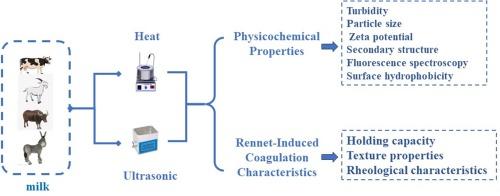超声波和热处理对不同品种牛奶的理化特性和凝乳酶诱导凝固特性的影响。
IF 9.7
1区 化学
Q1 ACOUSTICS
引用次数: 0
摘要
本研究探讨了热处理和超声波处理对奶牛、山羊、水牛和驴等不同种类牛奶的理化参数和凝乳酶诱导凝固特性的影响。对牛奶样品进行了不同温度(65 °C、80 °C、90 °C、100 °C)的热处理和不同功率(200 瓦、400 瓦、600 瓦、800 瓦、1000 瓦)的超声波处理。结果表明,超声波和热处理以及牛奶的种类都会改变浊度、粒度、ZETA电位、二级结构和表面疏水性。超声波处理牛奶会降低α-螺旋含量,同时增加β-匝含量。与对照样品相比,在类似的超声波处理下,山羊奶的β-片状含量显著增加,而β-匝和无规线圈含量则有所减少。值得注意的是,随着超声波处理和热处理强度的增加,所有四种牛奶形成的凝胶的持水量都显著增加。水牛奶凝胶的硬度在超声波和热处理后明显增加,从 63°C 30 分钟到 90°C 15 分钟不等,但牛奶和山羊奶凝胶的硬度与对照样品相比有不同程度的增加。此外,牛奶和山羊奶凝胶的储存模量(G')和损耗模量(G'')均高于水牛奶和驴奶凝胶,而且超声波和热处理会改变受检牛奶的G'和G''的变化。这些发现为改进牛奶加工程序以提高乳制品质量和实用性提供了重要启示。本文章由计算机程序翻译,如有差异,请以英文原文为准。

Impact of ultrasonic and heat treatments on the physicochemical properties and rennet-induced coagulation characteristics of milk from various species
This study investigates the effects of heat and ultrasonic treatments on the physicochemical parameters and rennet-induced coagulation properties of milk from a variety of species, including cow, goat, buffalo, and donkey. Milk samples were subjected to heat treatments at different temperatures (65 °C, 80 °C, 90 °C, 100 °C) and ultrasonic treatment at varying power levels (200 W, 400 W, 600 W, 800 W, 1000 W). The results revealed that changes in turbidity, particle size, zeta potential, secondary structure, and surface hydrophobicity were altered by both ultrasonic and heat treatments, as well as the kind of milk. Ultrasonic treatment of cow milk decreased α-helix content while increasing β-turn content. Under similar ultrasonic treatment, goat milk showed a considerable increase in β-sheet content, whereas β-turn and random coil contents decreased compared to control samples. Notably, the water-holding capacity of gels formed from all four types of milk increased significantly with the intensity of ultrasonic and heat treatments. The hardness of buffalo milk gels increased significantly after ultrasonic and thermal treatments, ranging from 63 °C for 30 min to 90 °C for 15 min, but the hardness of cow and goat milk gels increased in varying degrees compared to their control samples. Furthermore, gels from cow and goat milk had higher storage modulus (G’) and loss modulus (G’’) than those from buffalo and donkey milk, and changes in G’ and G’’ from the examined milk were altered by ultrasonic and heat treatments. These findings offer important insights into refining milk processing procedures to improve dairy product quality and usefulness.
求助全文
通过发布文献求助,成功后即可免费获取论文全文。
去求助
来源期刊

Ultrasonics Sonochemistry
化学-化学综合
CiteScore
15.80
自引率
11.90%
发文量
361
审稿时长
59 days
期刊介绍:
Ultrasonics Sonochemistry stands as a premier international journal dedicated to the publication of high-quality research articles primarily focusing on chemical reactions and reactors induced by ultrasonic waves, known as sonochemistry. Beyond chemical reactions, the journal also welcomes contributions related to cavitation-induced events and processing, including sonoluminescence, and the transformation of materials on chemical, physical, and biological levels.
Since its inception in 1994, Ultrasonics Sonochemistry has consistently maintained a top ranking in the "Acoustics" category, reflecting its esteemed reputation in the field. The journal publishes exceptional papers covering various areas of ultrasonics and sonochemistry. Its contributions are highly regarded by both academia and industry stakeholders, demonstrating its relevance and impact in advancing research and innovation.
 求助内容:
求助内容: 应助结果提醒方式:
应助结果提醒方式:


